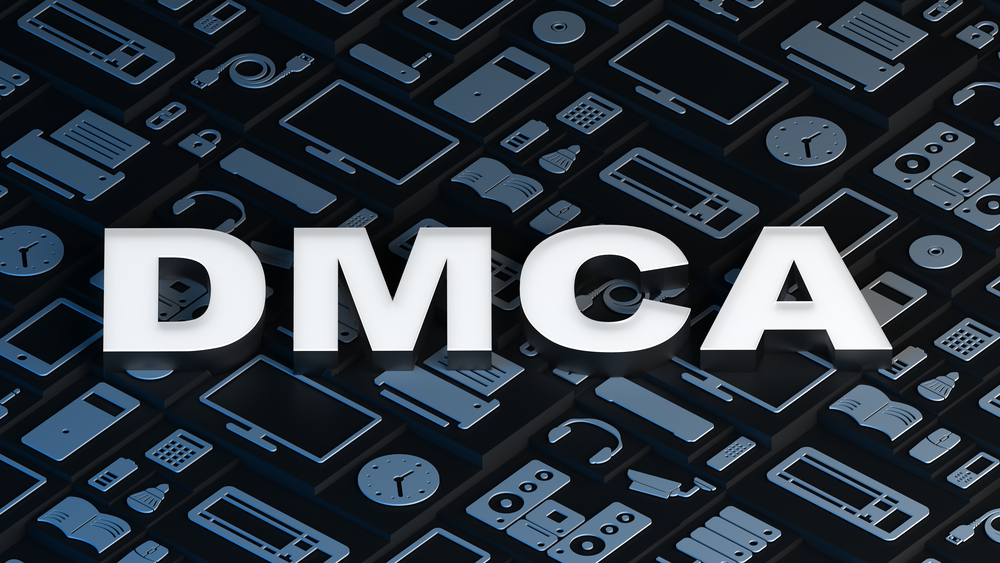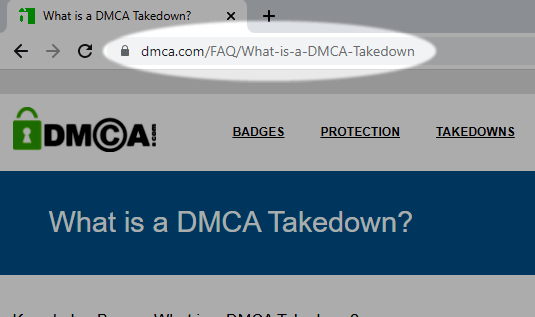
DMCA is Digital Millennium Copyright Act. It is a part of the US Copyright Law and relates to a defined process in removing content from the internet.
The DMCA is most commonly connected to a process known as a DMCA Takedown.
Click here to start a DMCA Takedown
Why is the DMCA important to you?
As part of the U.S. copyright law, the DMCA addresses the rights and obligations of owners of copyrighted material who believe their rights under U.S. copyright law have been infringed, particularly but not limited to, on the Internet. DMCA also addresses the rights and obligations of OSP / ISP (Internet Service Providers) on whose servers or networks the infringing material may be found.
This law clearly provides a framework, called the DMCA Takedown (Section 512 (c)(3)), for a process between two parties for the request and removal of copied content found online. For more information you can visit: www.copyright.gov/legislation/dmca.pdf.
Most websites, ISP's, OSP's, hosting companies have adopted the DMCA Takedown process to handle requests for the removal of illegally hosted content on websites within their control. If you think you can use the DMCA takedown process to get your content removed.
If you want to learn more about DMCA Takedowns please see our other FAQ on this specific issue here What is a DMCA Takedown.
What do I need to use DMCA to get my stolen content down from a website?
Three main pieces of information are needed to get started filing a DMCA Takedown Notice:
1. Infringing URL

Where on the internet or platform is your stolen content located? What is the link that you want the content removed from? Be sure to provide the URL or website/webpage link of the content you want removed. If the stolen content is an image or video located on a website provide the direct link of the content contained in the site. Copy and paste the infringing text, or provide the URL of the infringing image if required.
An example link would look like: https://www.badguy_site.com/webpage/image_2

2. Source URL
Where was your content located when it was stolen? Was it on your social media profile? Was it from your own website? Provide the exact URL where it was stolen from, even if the content has already been removed from its original location. The original URL is still valuable to the notice. If it was not online you can reference cell phone, computer, or camera etc. If it was online such as a website or cloud storage provide the link to the exact page it was stolen from. You can upload the original content to a cloud storage service and provide that URL with an explanation of where it was originally stolen from.
An example link would look like: https://share.icloud.com/photos/my_original_content
3. Description of Ownership

What is the content owner's name and how was the content stolen? How is this content yours? How do you own it? Did you create it, buy it, copyright it? Who is claiming ownership of the content? Who is authorized to file the DMCA Takedown? When did you create the content and when was the content stolen?
An example description would sound like: "My photo I took of myself on my camera was stolen from my Google Drive and was posted on this website without my knowledge and I would like it removed."
If you are unsure how to collect the information for these three categories the Professional Takedown Team at DMCA.com can help with the answers. Click here to ask us about your situation.
DMCA Fast Tip
Be Prepared. The information needed for DMCA is the same information needed for nearly all takedown notice requests regardless of legal country and legal jurisdiction.
Is DMCA for the USA only?
While the DMCA is part of USA Copyright Law. The DMCA Takedown process described within the law is widely used throughout the world. Most countries accept the standard DMCA Takedown Notice form and process. Although the DMCA Takedown is part of US Copyright law, a DMCA Takedown Notice is often used and accepted throughout the world and not exclusive to the United States. However, many countries have their own copyright laws specifically related to the removal of content from internet service providers and site owners within their borders. Which service providers do and do not accept the standard DMCA takedown notice form and process is dynamic and constantly changing. DMCA.com professionals are aware of these constant changes and are able to convert the information submitted through the standard DMCA Takedown signup form to suit specific countries and/or service providers within the legal process they require.
Does a website need to use the DMCA in order to get my content removed?
No. If a website does not clearly state they follow DMCA you can still process a DMCA Takedown Notice to remove your stolen content. There can be many reasons a website does not reference the DMCA directly.
How can I know if a website uses DMCA?
If a website uses the DMCA they will usually place a reference in the footer of the website. The clickthrough should clearly state the conditions of the DMCA Takedown process. Many websites reference the DMCA.com Takedown Notice form on this website directly. If you are unsure or the website unclear, click here to complete your takedown request: DMCA Takedown Form. Our professional team will connect your takedown request to the right website.
DMCA Takedown Testimonial
I can't place a price on peace of mind, when you've worked so hard to build a brand and someone steals your content and posts your images illegally, it can be extremely hurtful and damaging to the work you've created and the brand you've built. My experience with DMCA.com was uncomplicated, very informative, and an eye opener. I'm happily a pro member of the service now and will continue to protect my work and my brand with their help. Knowledge is power, arm yourself with a great team and never stop fighting for what's yours. Thank you DMCA.com!
How can I add the DMCA to my website?
DMCA.com's first recommendation is to contact a lawyer or law firm in the legal jurisdiction of your company or website to determine what is the appropriate legal communication. DMCA.com does not offer any legal advice or specific recommendation regarding any copyright practice.
DMCA.com has two programs to help content creators, publishers and UGC platforms:
- Content Publishers or Platforms of User Generated Content (UGC) should use the DMCA Compliance program - Get Compliant - adding a compliance badge to your site instantly takes the guess work and time out of processing DMCA Takedown notices on your site.
- Content Creators and Publishers (without UGC) should use DMCA.com Protection Pro - Content Protection - it is essential to add an ownership statement to all your content. Registering and adding your content and website to this program is click through easy. There is even a Free program so getting started is easy.
If you are unsure what program is best for your situation by all means reach out and one of the DMCA.com team can provide support: Help Me Choose the right option.
Related DMCA Takedown FAQ's
- What is the DMCA Protected Badge

- What is DMCA Protection
- What is DMCA Takedowns
- What is DMCA.com
- What is DMCA Protected Certificate
- What is DMCA Website Certificate
- What is DMCA Website Status Page and Protection Certificate